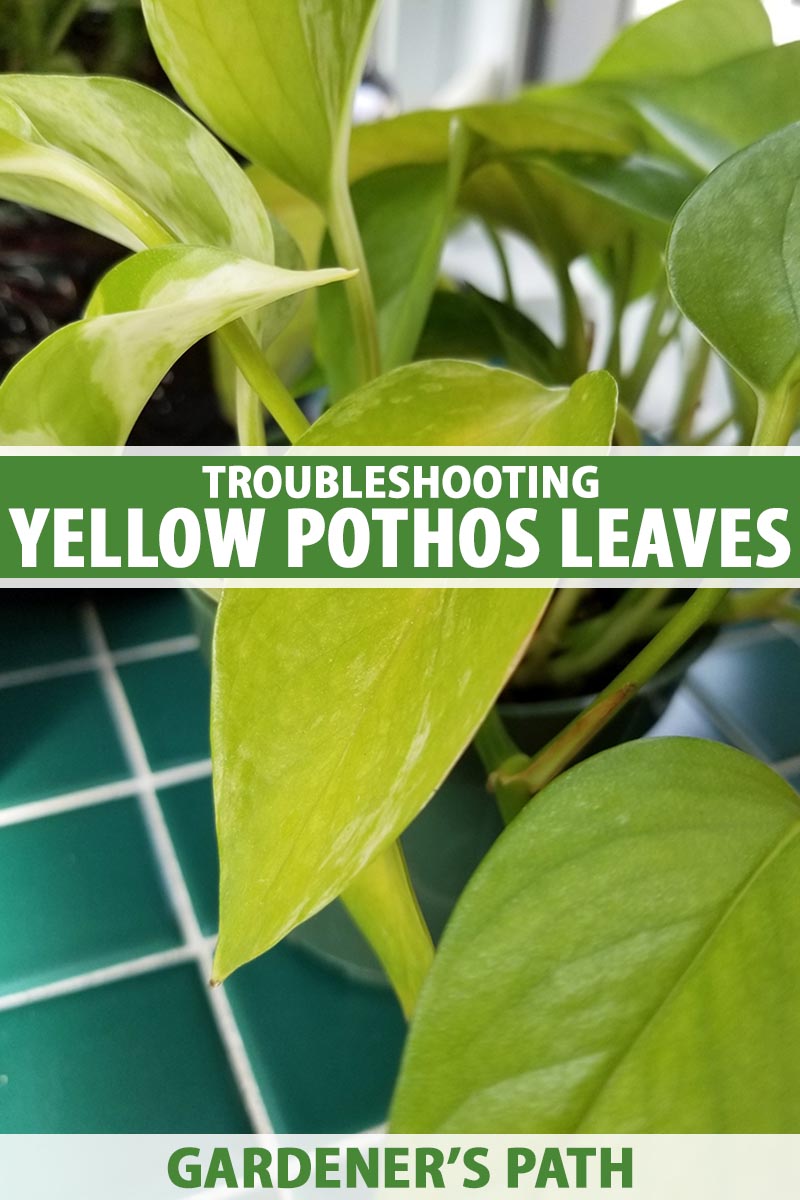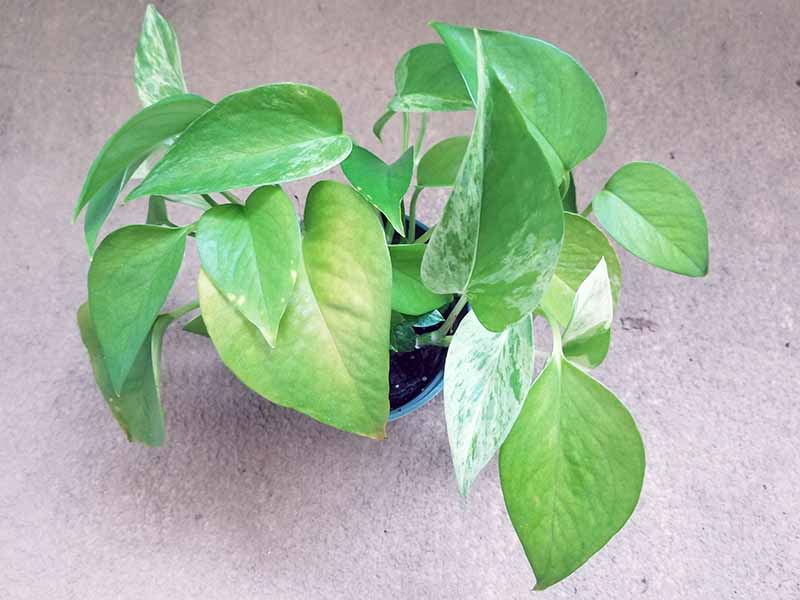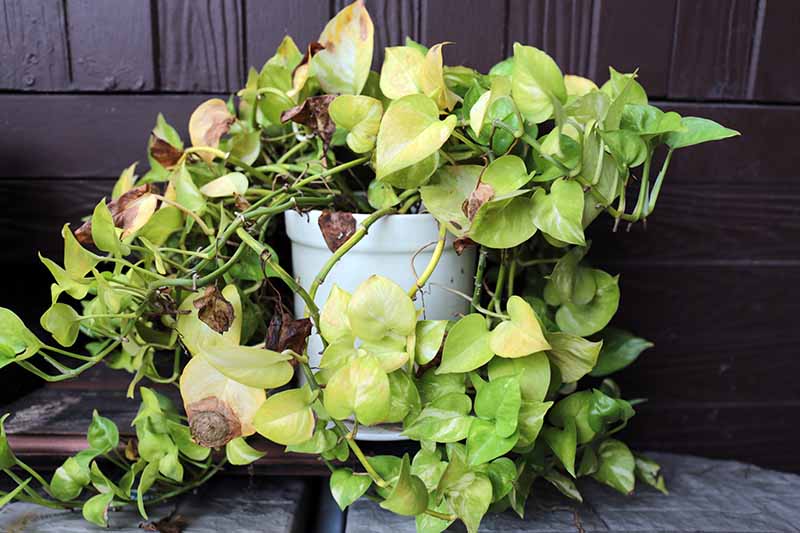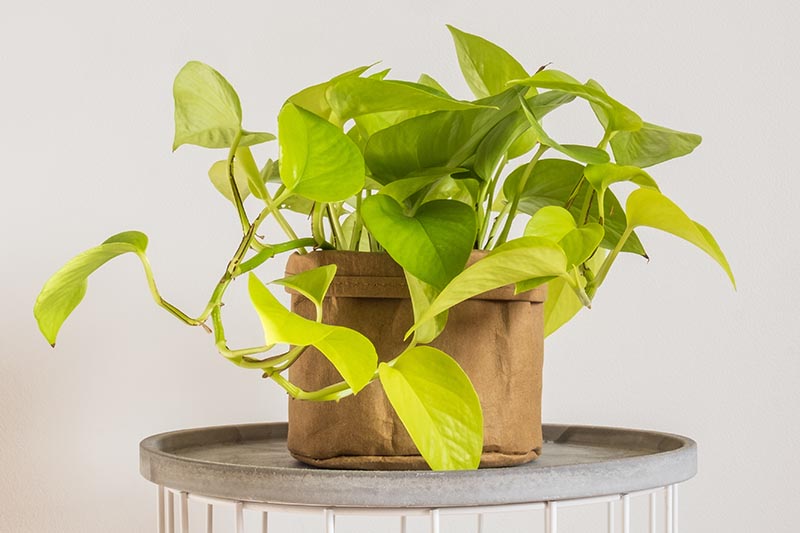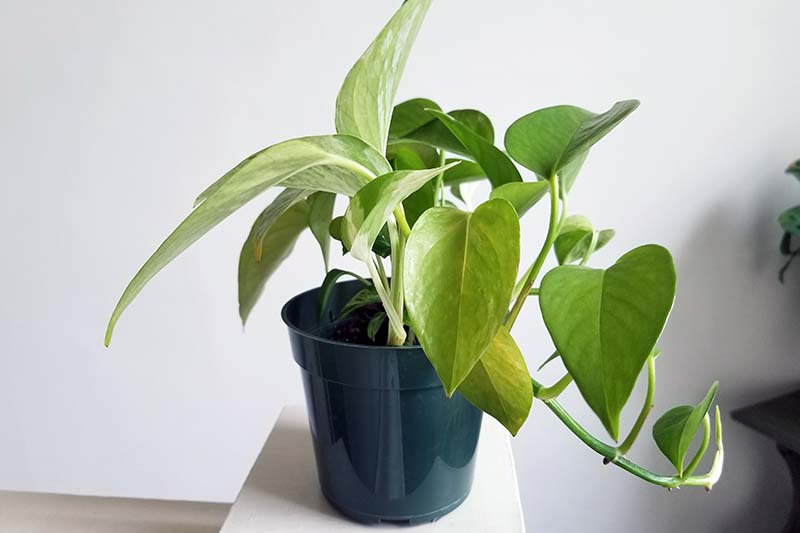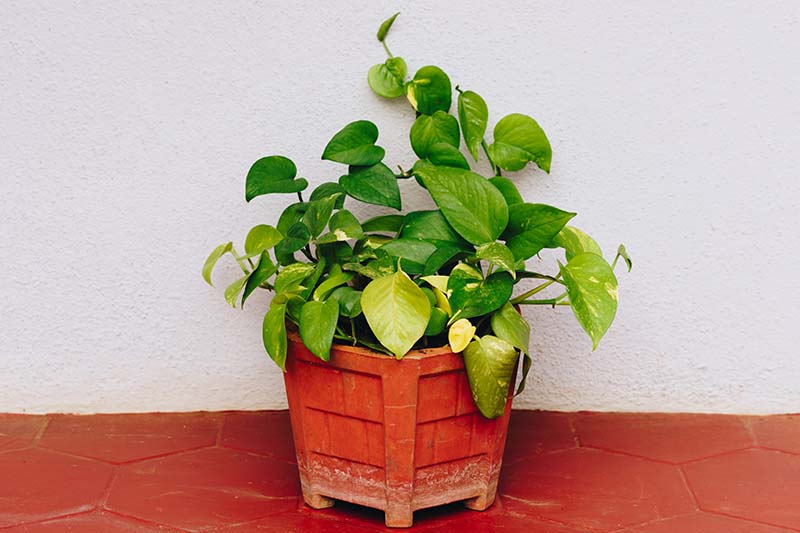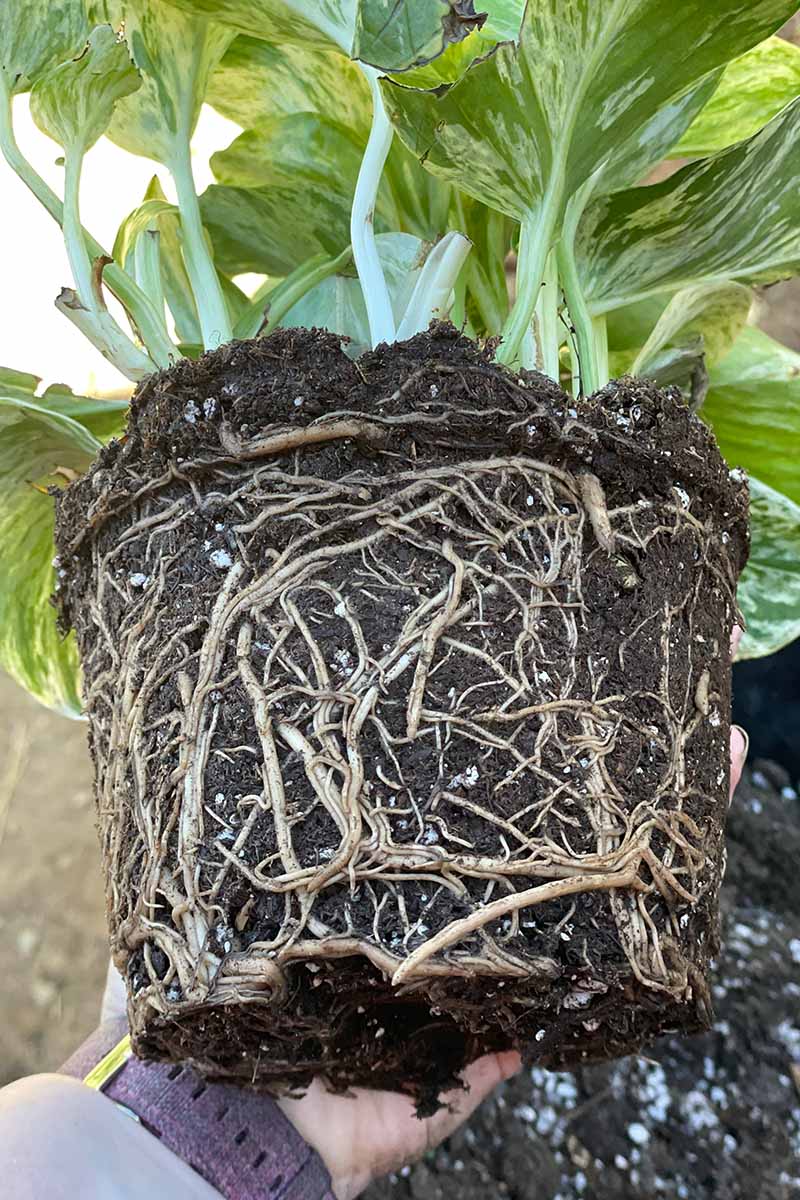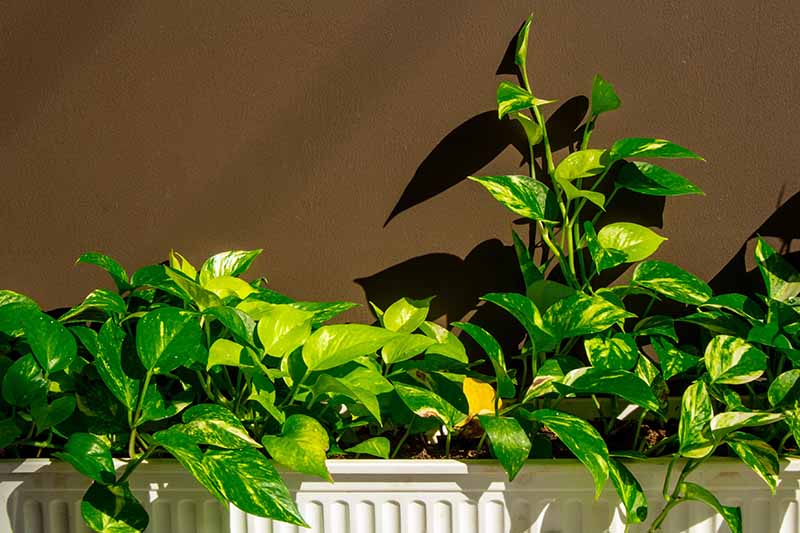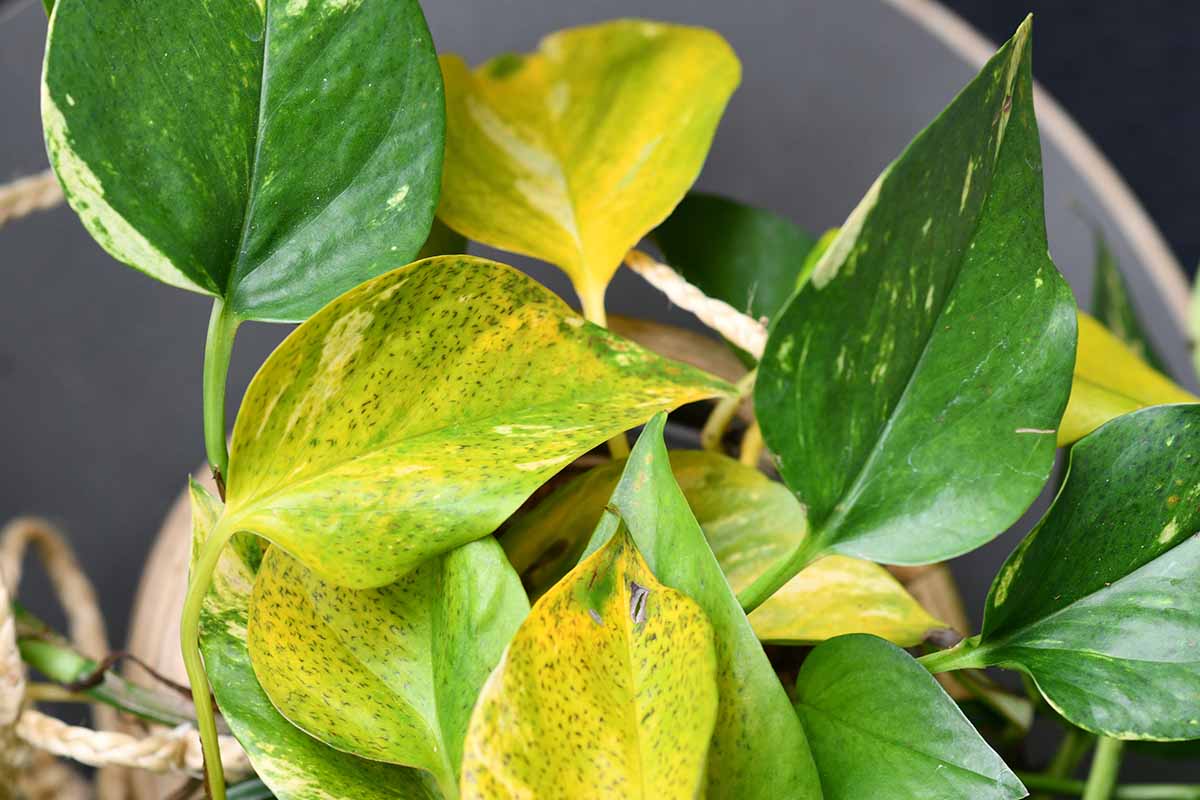Certain cultivars of Epipremnum aureum, also known as devil’s ivy, have yellow splashes on the variegated leaves, for example. And ‘Neon’ is a light lemon-lime color all over. But when healthy leaves on your houseplant or the cuttings you’re trying to root start turning yellow, you’ve got a problem. We link to vendors to help you find relevant products. If you buy from one of our links, we may earn a commission. Here’s the rundown:
What Makes Pothos Leaves Turn Yellow?
It’s hard to think of pothos getting sick when you so often see them thriving so readily indoors in homes and offices, as well as in planters in public spaces. I hope you’ll feel reassured when I tell you that most of the time, devil’s ivy really does live up to its easy-care reputation. So, what’s the number one cause of problematic yellow leaves? Pythium root rot. We’ll cover this issue first, followed by six other common problems that may cause sickly, discolored foliage. After that, I’ll conclude with recommended ways to stave off these common issues. Let’s take a look!
1. Root Rot
This common problem occurs when you overwater your pothos, or plant it in soil that doesn’t drain properly. Oversaturation suffocates the roots, and leaves plants prone to infection. With or without the presence of disease-causing pathogens, this can spell trouble for your pothos. Though plants that are stuck in oversaturated soil are dying from the roots up, you’ll see evidence of this in the discolored leaves. And when you notice the foliage turning yellow on many parts of a potted pothos, including the younger growth, root rot is the most likely culprit. One of the most prevalent types is Pythium root rot, and it’s caused by oomycetes or water molds in the Pythium genus that thrive in overly moist conditions. Since it causes the roots to turn to mush, it’s a good idea to rule it out as soon as you spot numerous leaves making that color change. These water molds also cause damping off, which can kill young seedlings. The pathogens can decimate cuttings, too, after turning their leaves a sickly yellow. If you’re rooting pothos cuttings in a glass of water, this condition is super easy to spot. If you see it, toss the cuttings and start over with new ones from a healthy plant, in fresh water and sterilized containers. I don’t like to be the bearer of bad news, but when your pothos has rotten roots, I strongly advise you to be ruthless and ditch it. You may be able to sniff out the musty, sharp odor of the rotting roots, but be sure to confirm by gently supporting the foliage in one hand and sliding the plant from its pot. If the roots are brown, mushy, and smell bad, take the hit and start over with a new plant. It’s possible (but not probable) that you’ll find only a few roots that are mushy and foul-smelling. If this is the case, you can cut them away and then repot in a sterile growing medium and a clean container. There are also fungicides that might take care of root rot if it hasn’t progressed too far, but they tend to cost more than a new houseplant. I don’t recommend trying one unless you already happen to have it on hand, or if your pothos is of such an advanced age or large size that it would be costly to replace.
2. Salty Soil
If you inspect the roots on a pothos with discolored leaves and they’re healthy and cream colored, you’ll need to consider other potential explanations. Applying too much fertilizer could be the culprit, since it adds so much salt to the soil. That saline buildup will damage the roots so they can’t keep the plant properly hydrated. This can stunt growth, and make the edges of the foliage look burnt and brown. It may also cause leaves to turn yellow, often starting at the tips. Damaged roots that fail to absorb water can also be a factor in root rot, and plants that are stressed in other ways are left more vulnerable to disease. If you haven’t detected root rot but you have been fertilizing more often than once every couple of months or so, try flushing some of the fertilizer and salt from the soil by drenching and draining the pot several times in succession. If your pothos responds favorably, perking up and producing fresh, green growth, that’s great! If it doesn’t, try rinsing the roots clear of soil and repotting in a fresh batch of growing medium. If the damage is severe, consider tossing the plant and trying again.
3. Sunlight
Whereas pothos plants are beloved for their ability to remain green even in low light conditions, they’ll bake in the sun. Too much direct light can cause some of the leaves to go from green to a scrambled egg color. You can easily take care of this by moving the plant to a new location where it will receive ample light without being hit by direct sun. Note that the affected leaves won’t return to their original shade after the move. You may still wish to prune away and dispose of them.
4. Time for Retirement
There are also a couple of instances when just a bit of the foliage may turn a lemon or butter color, but it’s not a big deal in this case since it isn’t caused by a disease, and it’s typically easy to remedy. If a couple of mature leaves do that, they’re usually just making way for new growth, and will fall off on their own in due course. You can clip them off with sanitized scissors if you prefer not to wait. This natural phenomenon is indicated by lemon-colored leaves that have an even tone of yellow across the entire leaf surface, and that are growing near the base, not at the tips of long stems. Sometimes, saying goodbye to the old leaves to make way for the new is just part of being a gardener, and it’s nothing to worry about. If you prune these away and the yellowing continues, or you notice other signs of a problem, it may be time to repot – more on that later.
5. Waiting to Transplant
Compacted, tightly bound roots could be at fault if the foliage is looking more lemony than usual. When a houseplant becomes too large for its container, the roots start growing around the inside instead of down, forming a mass. They may begin to grow up and out the top of the pot, or through the drainage holes as well. Then they’re no longer able to deliver nutrition to the plant, which can turn the leaves an unappealing color. A plant with container-bound roots will languish, and you’ll be able to see that the roots are coiling. If they don’t smell bad and aren’t brown, you may be able to restore your plant to good health by cutting out and disposing of any damaged parts of the entangled roots, unwinding or teasing them apart, and repotting in a larger container with adequate drainage holes and fresh, sterile soil.
6. Underwatering
Underwatering is another issue that may be at play, though it’s not usually much of a problem for pothos in comparison to other types of flora grown indoors. The tip-off here is soil that feels dry to the touch, with leaves that are butter colored. They will also begin to look crinkly, not plump and full of moisture like they would if they’d been overwatered. Alleviating the problem if you have underwatered is a quick fix. A good, deep drenching followed by ample time to drain should do the trick, along with a vow to be more conscientious in the future. If you’ve been on vacation or simply forgotten to water, soak the soil well, being careful to avoid sprinkling the leaves. Be sure to dump any liquid that’s run into the drainage saucer beneath the pot, since you don’t want to allow your plant to sit in standing water. Give it some time, and your pothos should bounce back. Note that any yellowed foliage will stay that color even after the plant recovers from dehydration, so you may want to trim it away with sterilized secateurs.
7. Yellow Halos: Bacterial Leaf Spot
You can spot this issue pretty easily. While it doesn’t cause the foliage to take on a whole new color across entire leaves, bacterial leaf spot does lead leaves to develop little water spots that are surrounded by yellow rings, known to us indoor gardeners as “halos.” Pseudomonas cichorii bacteria cause this effect, and the pathogens flourish when plants are subjected to too much water, top-watering that splashes onto the foliage, too little light, or any of the many stressful conditions that can generally make a plant unhealthy and susceptible to disease. The bad news is that once your pothos has been infected by this destructive bacteria and you can see the damage that’s already been done, you won’t be able to salvage it. The good news is that leaf spot is easily prevented. Continue reading for our tips.
Preventive Measures
Healthy plants are happy plants, and you can read more about growing and caring for pothos houseplants in our guide. The core indoor gardening strategies that help you to take good care of all of your houseplants will serve you well as you attempt to keep pothos leaves from turning yellow. For starters, use a sterile, porous potting mix when you transplant your houseplants. Ideally, this should be done about every year and a half to two years, before they become pot-bound. Remember to take a peek when you bottom water or if you’re shifting the container a bit to give the other side a chance to face towards the window. If you can see roots through the drainage hole, it’s time – and past time if they’ve already emerged through the hole. Also employ clean pots that are either new or that have been soaked in a solution of one part household bleach to nine parts water for 10 minutes, and then washed with liquid dish soap and water. Sanitizing the containers helps to prevent Pythium oomycetes from taking up residence in the soil where they can attack a host plant. Make sure the growing medium that you use drains well, and only select containers that offer adequate drainage. Using decorative cachepots is fine, as long as you pot your plant in another container with holes that water can drain through before placing it inside. Each time you water, check back after the excess moisture has had a chance to drain into the saucer or cachepot below, and make sure to empty it so the roots don’t get wet feet from sitting in soggy soil. So your plant can skip those yellowed leaf tips, fertilize adequately but don’t go overboard. Moderating your fertilizer application tactics will also help to prevent salt buildup in the soil, which can damage the roots and weaken the plant. Be sure to provide enough light so you don’t stress out the plant. Though pothos does well in low-light conditions, depriving it of light altogether is a no-no. Also avoid placing the pots anywhere with high humidity or where the temperature fluctuates by more than a couple of degrees. But don’t go overboard in the other direction – skip any locations that receive direct sunlight, or that are located immediately adjacent to heat registers or radiators. Also prevent those dreaded halo circles by watering only at the soil surface, instead of splashing the leaves by watering from above. Bottom-watering is another useful option to look into when caring for these plants. Read our guide for comprehensive instructions. Bacteria can survive and multiply in those droplets on the foliage, and any water that splashes on the leaves can transport disease pathogens to the roots of your precious pothos from the potting soil or plant stems. It’s comforting to know that one bad experience with a sick pothos doesn’t have to set the tone for your houseplant experience moving forward. Even if you must toss a languishing plant, you can always start a new one from healthy cuttings, or purchase another small specimen inexpensively. Make any needed adjustments to the way you water, and you’ll probably resume an “easy-care” relationship with this hard-to-kill indoor plant. Do you have experience, either with bringing a devil’s ivy plant back to life after the leaves started looking jaundiced, or making the pragmatic decision to remove it from the household? Kindly share lessons learned or any questions you have for us in the comments section below. And if you found this troubleshooting guide valuable and are on a quest to add more live plants indoors, check out these easy-care houseplant guides next:
3 Foolproof Ways to Propagate Pothos PlantsHow to Grow and Care for PhilodendronHow to Grow and Care for Aloe Vera
